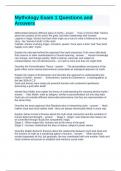-
1. Exam (elaborations) - Greek mythology questions and answers
-
2. Exam (elaborations) - Mythology unit questions and answers
-
3. Exam (elaborations) - Mythology questions and answers 100% correct
-
4. Exam (elaborations) - Mythology chapters 1-3 questions and answers
-
5. Exam (elaborations) - Mythology midterm review questions and answers graded a+
-
6. Exam (elaborations) - Mythology test questions and answers
-
7. Exam (elaborations) - Greek mythology questions and answers
-
8. Exam (elaborations) - Mythology exam 2 questions and answers
-
9. Exam (elaborations) - Mythology questions and answers
-
10. Exam (elaborations) - Mythology exam 1 questions and answers 100% correct
-
11. Exam (elaborations) - Mythology module 1 questions and answers
-
12. Exam (elaborations) - Mythology gods questions and answers graded a+
-
13. Exam (elaborations) - Mythology questions and answers
-
14. Exam (elaborations) - Mythology questions and answers
-
15. Exam (elaborations) - English chapter 1-4 mythology questions and answers
-
16. Exam (elaborations) - Mythology unit 1 study guide questions and answers
-
17. Exam (elaborations) - World mythology questions and answers
-
18. Exam (elaborations) - Classical mythology- exam 1 questions and answers
-
19. Exam (elaborations) - Greek and roman mythology questions and answers 100% correct
-
20. Exam (elaborations) - Greek mythology and literature questions and answers
-
21. Exam (elaborations) - Mythology part 2 questions and answers graded a+
-
22. Exam (elaborations) - Edith hamilton's mythology questions and answers
-
23. Exam (elaborations) - Mythology chapter 1 questions and answers
-
24. Exam (elaborations) - Greek mythology questions and answers
-
25. Exam (elaborations) - Greek mythology (heroes chart) questions and answers
-
26. Exam (elaborations) - Classical mythology unit 1 questions and answers
-
27. Exam (elaborations) - Mythology by edith hamilton questions and answers
-
28. Exam (elaborations) - *mythology timeless tales of gods and heroes* questions and answers
-
29. Exam (elaborations) - (part 2) mythology by edith hamilton questions and answers
-
30. Exam (elaborations) - Introduction to classical mythology questions and answers
-
31. Exam (elaborations) - Worksheets for mythology questions and answers
-
32. Exam (elaborations) - Neil gaiman's norse mythology questions and answers
-
33. Exam (elaborations) - Creation (greek mythology) questions and answers
-
34. Exam (elaborations) - Greek mythology gods and goddesses power questions and answers
-
35. Exam (elaborations) - Norse mythology questions and answers
-
36. Exam (elaborations) - Greek mythology characters
-
37. Exam (elaborations) - Greek mythology gods & goddesses questions and answers
-
38. Exam (elaborations) - Myths questions and answers
-
39. Exam (elaborations) - Greek myths questions and answers
-
40. Exam (elaborations) - Roman mythology questions and answers
-
41. Exam (elaborations) - Mythology-theseus questions and answers
-
42. Exam (elaborations) - Greek mythology stories questions and answers
-
43. Exam (elaborations) - Greek mythology - the underworld questions and answers
-
44. Exam (elaborations) - Trojan war—mythology questions and answers
-
45. Exam (elaborations) - 10 characteristics of a myth questions and answers
-
46. Exam (elaborations) - Greek mythology hercules questions and answers
-
47. Exam (elaborations) - Greek mythology questions and answers
-
48. Exam (elaborations) - Norse mythology questions and answers
-
49. Exam (elaborations) - Egyptian mythology questions and answers
-
50. Exam (elaborations) - Mtu mythology questions and answers
-
51. Exam (elaborations) - The underworld (greek mythology) questions and answers
-
52. Exam (elaborations) - Mythology questions and answers
-
53. Exam (elaborations) - Mythology study guide questions and answers
-
54. Exam (elaborations) - What is a myth questions and answers
-
55. Exam (elaborations) - Mythology facts questions and answers
-
56. Exam (elaborations) - Myths questions and answers
-
57. Exam (elaborations) - Mythology-questions and answers graded a+
-
58. Exam (elaborations) - Greek mythology flashcards questions and answers
-
59. Exam (elaborations) - Mythology exam 1 questions and answers
-
60. Exam (elaborations) - Mythology test 1 questions and answers
-
61. Exam (elaborations) - The function of mythology questions and answers
-
62. Exam (elaborations) - Mythology questions and answers
-
63. Exam (elaborations) - Mythology and folklore units 1-4 questions and answers
-
64. Exam (elaborations) - Greek mythology test study guide questions and answers
-
65. Exam (elaborations) - Gods and goddesses of greek mythology questions and answers
-
66. Exam (elaborations) - Mythology questions and answers
-
67. Exam (elaborations) - Mythology review questions and answers
-
68. Exam (elaborations) - Greek mythology questions and answers
-
69. Exam (elaborations) - Mythology midterm questions and answers
-
70. Exam (elaborations) - World mythology questions and answers
-
71. Exam (elaborations) - Mythology questions and answers
-
72. Exam (elaborations) - Mythology norse gods questions and answers
-
73. Exam (elaborations) - Mythology introduction questions and answers
-
Show more




